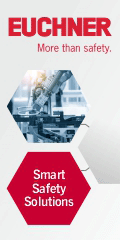
Posted to News on 19th Jun 2025, 14:30
Enhanced, position-based synchronisation control option for select actuators
Thomson Industries has announced the availability of an enhanced synchronisation option for its Electrak HD smart electric linear actuator. The new iteration of this control option implements position-based synchronisation within the actuators' onboard electronics for modern motion control applications requiring instant load balancing of multiple Electrak HD units.

"We worked closely with industrial equipment builders who need dynamic and reliable load synchronisation and redesigned our controls to meet their demands. By incorporating advanced position sensing and communication capabilities, we have streamlined the process of synchronising multiple actuators. This enhancement helps users achieve increased efficiency, strength and safety in heavy duty applications," said Anders Karlsson, Senior Product Manager - Linear Actuators at Thomson.
Actuators in lockstep
The synchronisation option can support up to eight Electrak HD actuators that connect in real time across a CAN bus network, ensuring operation in perfect harmony. A constant heartbeat signal in each actuator maintains position awareness for all units. If one actuator senses a heavier load, it will signal to the others to slow their speed to maintain the same position. Only in the instance of a fault (loss of communication or power, or excessive voltage or temperature) on one or more of the actuators will the entire system shut down. This instant communication prevents binding or buckling, enhancing reliability and safety.
Unlike position-based actuators which require space-consuming external controls, the Electrak HD embeds all synchronisation functionality into its built-in electronics, making the system truly plug and play. All mounted and wired actuators can begin synchronising immediately following installation.
The Electrak HD can handle dynamic loads of up to 16 kN, making it a popular choice for applications where hydraulic cylinders were traditionally used. Its improved synchronisation capabilities make the HD particularly suitable for systems that require dynamic load balancing and position control - features that Thomson says are not achievable with conventional hydraulic cylinders.
Want the latest machine building news straight to your inbox? Become a MachineBuilding member for free today >>















